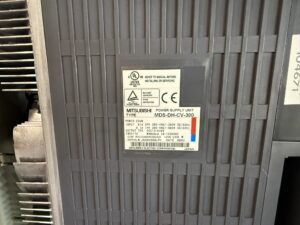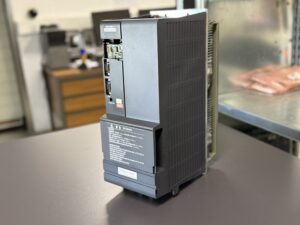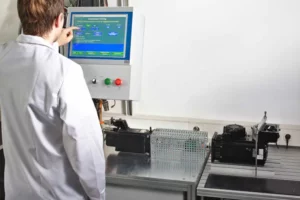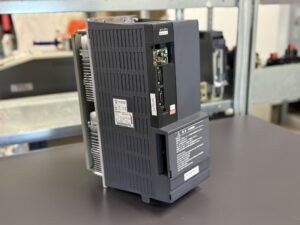11.05.2025 by Viktor Siebert
Overhaul and Testing of a Mitsubishi MDS-DH-CV-300 Power Supply Unit
Special Features of the Mitsubishi MDS-DH-CV-300.
The MDS-DH-CV-300 from Mitsubishi is a powerful power supply unit designed for CNC servo drive systems. It supplies multiple servo and spindle amplifiers with DC voltage and continuously monitors various parameters. What makes this device special?
- High Output Power: According to Mitsubishi manual IB-1500875, this unit provides up to 30 kW (30 min rated operation) and 26 kW continuous power . It operates on three-phase AC power (380–440 V at 50 Hz / up to 480 V at 60 Hz) and delivers approx. 72 A DC output (bus voltage ~500–650 V), sufficient to power multiple axis and spindle motors simultaneously. (See Manual IB-1500875, p. 1-12)
- Energy Regeneration: The MDS-DH-CV series features intelligent power regeneration control. During axis deceleration, braking energy is fed back into the grid instead of being dissipated as heat . If the regenerated energy exceeds safe limits, a braking resistor dissipates the surplus . (See Manual IB-1500875, p. 3-8)
- Comprehensive Protection: The MDS-DH-CV-300 includes protection against input phase failure, frequency deviation, overcurrent, overvoltage, overheating, and ground faults. It displays alarm codes when faults occur and automatically disables outputs.
- Robust Industrial Design: The device is built as a cabinet-insert module with a large heatsink and forced cooling. Mitsubishi recommends using matching AC reactors and protective equipment for safe operation (see table in manual, p. 1-12). Its durability ensures long service life in demanding environments.
In summary, the MDS-DH-CV-300 is a core component of Mitsubishi CNC systems—offering high performance, intelligent energy handling, and advanced protection features tailored for complex machine tools.
Repair and Overhaul in Our Workshop
After years of operation or in case of faults (often indicated by alarm codes), defective MDS-DH-CV-300 units are sent to us for repair and overhaul. One such unit arrived recently, causing sporadic shutdowns on the customer’s machine.
Diagnosis: Initial inspection showed no visible damage—no burn marks, no blown fuses. However, under simulated load, the unit intermittently failed. The problem appeared to be thermal instability in a power module (IGBT). This is a known failure pattern with aged components.
Repair Procedure: We fully disassembled and cleaned the unit. Worn parts such as DC bus electrolytic capacitors were replaced, as aging reduces their capacity and can destabilize the system. The cooling fan was also replaced due to bearing noise. The defective IGBT module and its drivers were swapped with OEM parts. Solder joints were reflowed or repaired as needed.
We also tested all connectors, relays, and fuses, and checked the main contactor under load. A thorough visual inspection of all boards revealed several areas where preventive replacement was justified. This ensures long-term reliability beyond just eliminating the immediate fault.
Final Load Test – Why It’s Essential
After any repair, the final test is crucial. With a unit like the MDS-DH-CV-300, simply powering it on is not enough. We conduct full load and function tests that replicate real-world machine conditions.
Using our test stand, we connect the unit to simulated motors and resistive loads and operate it under dynamic cycles. This reveals hidden issues—like thermal faults or unstable voltage—that don’t appear during idle testing.
Why bother? One example speaks volumes: a customer had the same model repaired elsewhere, but no load test was done. It worked initially but failed after a few hours due to a faulty thermal sensor that only triggered under load. A proper final test would have caught this before the unit was returned.
During our final test, we log voltages, currents, temperatures, and alarms using diagnostic tools and CNC feedback. Only when the unit operates flawlessly under extended stress testing do we approve it for return.
Our Professional Test Stand and Quality Process
We operate a dedicated CNC test bench, designed specifically for Mitsubishi drive components. Key features include:
- Real Load Simulation: We stress the 30 kW unit with full load and regenerative cycles. This includes energy feedback handling, braking resistor testing, and thermal behavior observation.
- Data Recording: We monitor bus voltages, fan speeds, currents, and internal temperature sensors. Any deviation is flagged for review.
- Safety Circuit Tests: Emergency stop behavior, fan alarms, and regeneration errors are tested in live simulations. This ensures that all protection functions work reliably post-repair.
In addition, we replace known wear components during overhaul. This includes electrolytic capacitors and fans—parts that often fail silently over time. Our proactive approach means the customer gets a unit that often works better than new.




To mentioned Mitsubishi Drive: Mitsubishi AC Power Supply MDS-DH-CV-300
More details about our Mitsubishi repair services can be found here:
Mitsubishi drive Repair by Industrypart
We regularly repair similar models, including:
MDS-D-CV-300
📞 Feel free to contact us with any questions about your Yaskawa drive technology.
Our expert team is happy to help!
Common Alarm Codes and Troubleshooting
The MDS-DH-CV-300 generates various alarm codes visible on the CNC display or the unit’s LEDs. Each code points to a specific issue. Based on Mitsubishi manual IB-1500875 (chapter 6.2, p. 6-8), here is a summary of key power unit alarms:
| Code | Description | Cause | Reset | Recommended Action |
|---|
| 61 | Power module overcurrent | Output short, overload, defective power transistor | PR | Check motor leads, reduce load, replace power stage if needed |
| 67 | Input phase interruption | One AC phase missing or loose terminal | PR | Check all three phases, tighten terminals |
| 69 | Ground fault (motor cable touches FG) | Cable insulation fault, moisture in connectors | PR | Measure insulation, inspect motor, dry and repair |
| 72 | Fan stop (overheat due to cooling fail) | Fan blocked or worn, dust buildup | PR | Replace fan, clean heatsink, allow cooling before restart |
| 73 | Over regeneration (braking overload) | Excessive deceleration energy, undersized resistor | NR | Adjust decel profiles, check and size braking resistor |
| 75 | DC bus overvoltage | High input voltage, regen feedback spike | NR | Install surge protector, wait before reset |
| 77 | Module overheat | High ambient temp, failed cooling, sustained high load | PR | Improve cooling, check environment, reduce load if needed |
Conclusion
Repairing a Mitsubishi MDS-DH-CV-300 requires deep technical knowledge and the right tools. Our team follows a step-by-step process: understanding the device, professional repair, preventive replacement, and rigorous load testing. This ensures the power supply is fully operational and reliable.
With our advanced CNC test bench and experience in Mitsubishi components, we offer reliable repairs that restore—and often exceed—the original performance. After our overhaul, the MDS-DH-CV-300 is ready for full-duty production with confidence.